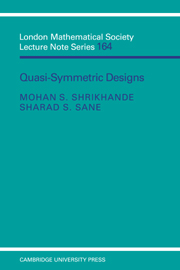Book contents
- Frontmatter
- Contents
- Preface
- Acknowledgments
- I Basic results from designs
- II Strongly regular graphs and partial geometries
- III Basic results on quasi-symmetric designs
- IV Some configurations related to strongly regular graphs and quasi-symmetric designs
- V Strongly regular graphs with strongly regular decompositions
- VI The Witt designs
- VII Extensions of symmetric designs
- VIII Quasi-symmetric 2-designs
- IX Towards a classification of quasi-symmetric 3-designs
- X Codes and quasi-symmetric designs
- References
- Index
VII - Extensions of symmetric designs
Published online by Cambridge University Press: 05 May 2010
- Frontmatter
- Contents
- Preface
- Acknowledgments
- I Basic results from designs
- II Strongly regular graphs and partial geometries
- III Basic results on quasi-symmetric designs
- IV Some configurations related to strongly regular graphs and quasi-symmetric designs
- V Strongly regular graphs with strongly regular decompositions
- VI The Witt designs
- VII Extensions of symmetric designs
- VIII Quasi-symmetric 2-designs
- IX Towards a classification of quasi-symmetric 3-designs
- X Codes and quasi-symmetric designs
- References
- Index
Summary
An important class of quasi-symmetric designs is the class of symmetric designs characterized among the former larger class by the property of having only one block intersection number. Though the symmetric designs by themselves are improper quasi-symmetric designs, as we already saw in Theorem 1.29, the extendable symmetric designs open up many possibilities for the parameter sets of proper quasi-symmetric designs. In fact, the classification theorem of Cameron (Theorem 1.29) has given rise to a considerable activity in the area of quasi-symmetric 2 and 3-designs. We will choose to postpone these topics to later chapters and concentrate here on the structure of those 3-designs that can be obtained as extensions of symmetric designs. In doing so, we will also consider some other quasi-symmetric designs (such as a residual design) associated with the extension process.
Recalling Cameron's Theorem, observe that it classifies extendable symmetric designs into four sets: an infinite set of symmetric designs the first object of which is a projective plane of order four, an infinite set of all the Hadamard 2-designs, a projective plane of order ten and a symmetric (495, 39, 3)-design. The existence of a Hadamard 2-design is equivalent to the existence of the Hadamard matrix of corresponding order. Nothing is known about a (495, 39, 3)-design. In this chapter, we first consider the extension question of a projective plane of order ten.
- Type
- Chapter
- Information
- Quasi-symmetric Designs , pp. 122 - 140Publisher: Cambridge University PressPrint publication year: 1991



